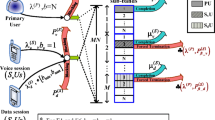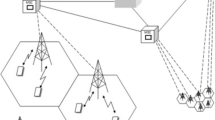Abstract
Wireless Broadband Cognitive Networks (WBCN) are new trend to better utilization of spectrum and resources. However, in multiservice WBCN networks, call admission control (CAC) is a challenging point to effectively control different traffic loads and prevent the network from being overloaded and thus provide promised quality of service. In this paper, we propose a CAC framework and formulate it as an optimization problem, where the demands of both WBCN service providers and cognitive subscribers are taken into account. To solve the optimization problem, we developed an opportunistic multivariate CAC algorithm based on a joint optimization of utility, weighted fairness, and greedy revenue algorithms. Extensive simulation results show that, the proposed call admission control framework can meet the expectations of both service providers and subscribers in wireless broadband cognitive networks.











Similar content being viewed by others
References
Andrews, J. G., Ghosh, A., & Muhamed, R. (2007). Fundamentals of WiMAX: Understanding broadband wireless networking. Upper Saddle River: Prentice Hall.
Khedr, M., & Shatila, H. (2009). Cogmax: A cognitive radio approach for WiMAX systems. Computer systems and applications. AICCSA 2009 (pp. 550–554). In IEEE/ACS international conference on.
Rong, B., Qian, Y., Lu, K., Chen, H., & Guizani, M. (July 2008). Call admission control optimization in WiMAX networks. IEEE Transactions on Vehicular Technology, 57(4), 2509–2522.
Rong, B., Qian, Y., & Lu, K. (2007). Integrated downlink resource management for multiservice WiMAX networks. IEEE Transactions on Mobile Computing, 6(6), 621–632.
IEEE 802.16-2004 (October 2004) IEEE standard for local and metropolitan area networks—part 16: Air interface for fixed broadband wireless access systems.
Yang, O., & Lu, J. (2006). A new scheduling and CAC scheme for real-time video application in fixed wireless networks. CCNC IEEE, pp. 303–307.
Ross, K. W., & Tsang, D. H. K. (1989). The stochastic knapsack problem. IEEE Transactions on Communications, 37(7), 884–895.
Altman, E., Jimenez, T., & Koole, G. (2001). On optimal call admission control in resource-sharing system. IEEE Transactions on Communications, 49(9), 1659–1668.
Sarangan, V., Ghosh, D., Gautam, N., & Acharya, R. (2005). Steady state distribution for stochastic knapsack with bursty arrivals. IEEE Communications Letters, 9(2), 187–189.
Beard, C. C., & Frost, V. S. (2001). Prioritized resource allocation for stressed networks. IEEE/ACM Transactions on Networking, 6(5), 618–633.
Bonald, T., & Roberts, J. W. (2012). Internet and the Erlang formula. SIGCOMM Computer Communications Review, 42(1), 23–30.
Wang, L., Liu, F., Ji, Y., & Ruang N. (2007). Admission control for non-pre-provisioned service flow in wireless metropolitan area networks (pp. 243–249). In Proceedings of fourth european conference on universal multiservice networks, Toulouse, France.
Song, G., & Li, Y. G. (2005). Cross-layer optimization for OFDM wireless networks—part I: Theoretical framework. IEEE Transactions on Wireless Communication, 4(2), 614–624.
Song, G., & Li, Y. G. (2005). Cross-layer optimization for OFDM wireless networks—part II: Algorithm development. IEEE Transactions on Wireless Communication, 4(2), 625–634.
Gunawardena, S., & Zhuang, W. (2011). Capacity analysis and call admission control in distributed cognitive radio networks. Wireless Communications, IEEE Transactions on, 10(9), 3110–3120.
Wang, H., Ding, L., Pan, Z., Liu, N., & You, X. (2011). QoS guaranteed call admission control with opportunistic scheduling (pp. 1–5). In Global telecommunications conference (GLOBECOM 2011), 2011 IEEE.
Tsai, M. H., Sung, J. T., & Huang, Y. M. (2010). Resource management to increase connection capacity of real-time streaming in mobile WiMAX. IET Communications, 4(9), 1108–1115.
Author information
Authors and Affiliations
Corresponding author
Rights and permissions
About this article
Cite this article
Khedr, M.E., Hassan, R.N.M. Opportunistic call admission control for wireless broadband cognitive networks. Wireless Netw 20, 105–114 (2014). https://doi.org/10.1007/s11276-013-0596-7
Published:
Issue Date:
DOI: https://doi.org/10.1007/s11276-013-0596-7




